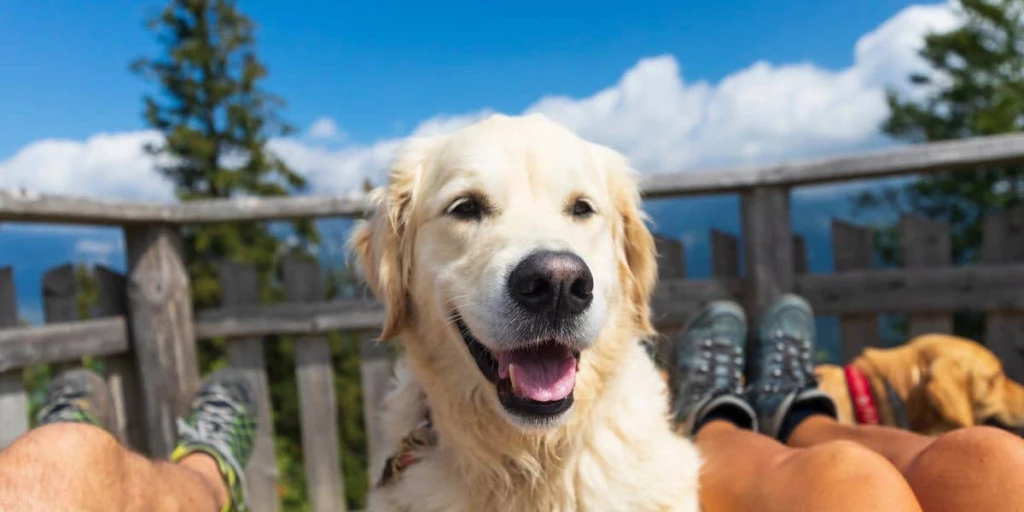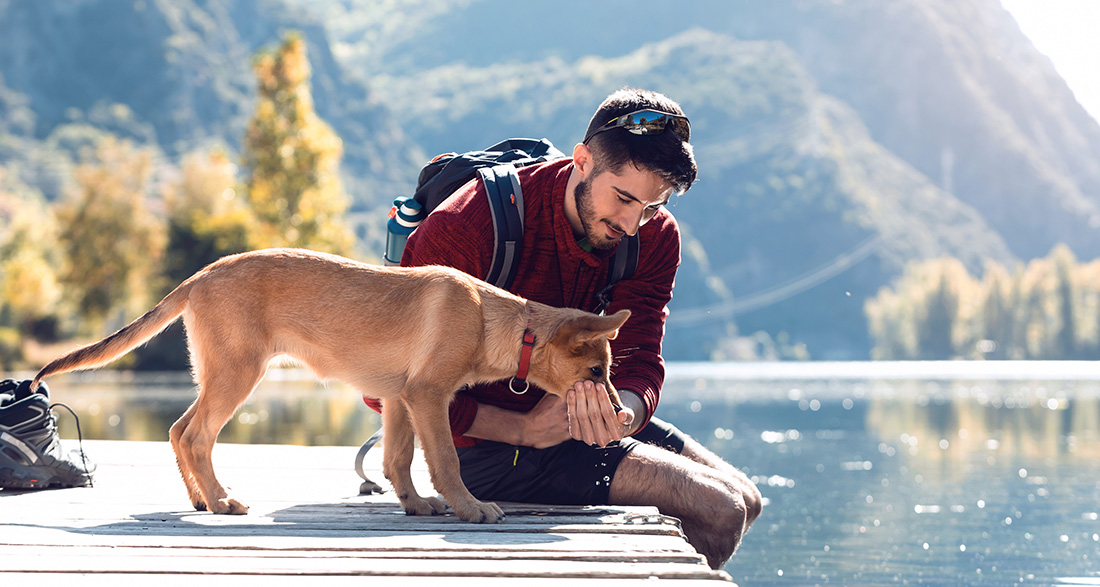Summer is vacation time, and what could be more delightful than traveling with your beloved dog and experiencing new adventures together? Before you embark on your summer vacation with your faithful companion, there are a few important things to consider.
Our veterinarian, Sarah, takes you on a summer journey, providing tips, tricks, and helpful reminders to ensure a wonderful vacation with your dog.
- Basic Tips for a Beach Vacation with Your Dog
- Anglers, Heat & Co.: These Summer Vacation Specifics Can Harm Your Dog
- How to Protect Your Dog from Overheating and Dehydration in Summer
- Hiking with Your Dog in Summer: How to Properly Prepare Yourself and Your Four-Legged Companion
- Conclusion
- Frequently Asked Questions
Here are the key points:
Anglers and Hooks: When walking your dog in areas where fishing is common, be careful that he doesn’t get entangled in fishing lines or swallow fishing hooks. If it does happen, seek immediate veterinary attention.
Heat: Dogs can quickly become dehydrated and suffer from heatstroke in high temperatures. Ensure your dog always has access to an ample water supply and doesn’t stay in the sun for too long. Walks are best scheduled during the early morning or late evening hours.
Toxic Plants: Some plants that bloom in summer can be toxic to dogs, such as oleander or azaleas. Make sure your dog doesn’t chew on or rub against these plants.
Harmful Foods: While on vacation, it might be tempting to treat your dog to something from the grill or a restaurant. However, be cautious, as chocolate, onions, and garlic are examples of foods that can be toxic to dogs.
Crowded Beaches: Beaches can be very crowded in summer, causing stress for some dogs. Ensure your dog has enough space and tranquility, free from disturbances by strangers or other dogs.
Basic Tips for a Beach Vacation with Your Dog
Fun in the water, cooling off, and sand as far as the eye can see. Be mindful of potential health risks associated with sand and swimming.
When playing and swimming with your dog at the beach, a lot of sand can get into their eyes, leading to an uncomfortable conjunctivitis. To prevent this, check your dog’s eyes after a beach visit and have soothing eye drops if necessary.
However, that’s not the only danger lurking at the beach. Your dog can also suffer from something called sand colic if they swallow too much sand. This condition manifests as gastrointestinal cramps and blockages, and if left untreated, it can quickly become fatal. If you notice initial signs, such as vomiting or diarrhea after beach play, promptly consult a veterinarian.
After the beach visit:
- Check your dog’s eyes after a beach walk to avoid conjunctivitis (bring soothing eye drops).
- If there are strong waves, limit water play, especially if your dog is not a strong swimmer.
- Ensure your dog has enough fresh drinking water to prevent drinking seawater and avoid salt poisoning.
- Rinse your dog with tap water after swimming in the sea to remove sand and salt from the fur.
- Symptoms of sand colic include gastrointestinal cramps and blockages. Untreated sand colic can be fatal. Seek veterinary attention at the first signs such as vomiting or diarrhea.

As a proud dog owner, you have the opportunity to let your four-legged friend enjoy the beach and the open sea. However, you should pay special attention to your dog.
During heavy waves, it’s advisable to play in the water briefly, especially if your dog is not a strong swimmer. It’s crucial to bring enough fresh drinking water to ensure your dog doesn’t drink salty seawater. Drinking seawater can disrupt your dog’s body balance (dehydration) as it has a higher salt content than blood. The body then tries to balance and eliminate the excess salt, a process that the kidneys can handle with enough drinking water.
Upon returning to the vacation home, it’s a good idea to rinse your dog with tap water. This prevents the dog’s fur from becoming matted, and it removes any remaining grains of sand. This way, you can prepare for a pleasant evening.
What to Consider When Bathing in the Sea:
- Be Mindful of Your Dog in Open Seas
- Play in the water briefly during strong waves, especially if your dog is not a strong swimmer.
- Bring enough fresh drinking water to prevent your dog from drinking salty seawater.
- The body can be thrown off balance when ingesting seawater (Dehydration).
- Rinse your dog with tap water after swimming.
- Prevents matted fur and removes remaining grains of sand.
Anglers, Heat & Co.: These Summer Vacation Specifics Can Harm Your Dog
A shared vacation with your dog by the sea can be a wonderful experience; however, there are some things to consider to ensure your dog’s health and safety.
A stroll along the promenade or on the pier and proximity to the water can be a highlight for you and your dog during your summer vacation. Yet, always remember to stay attentive and be mindful of your dog’s needs.
How to Protect Your Dog from Overheating and Dehydration in Summer
A hot summer month always carries the risk of heatstroke and dehydration, especially in high temperatures and intense sunlight. Therefore, as a dog owner, it’s essential to take some precautions to protect your four-legged friend from these dangers.
Luckily, there are some simple measures you can take to keep your dog happy and healthy even on hot days.
Practical Tips:
- Ensure your dog always has access to fresh water.
- Avoid walking your dog in direct sunlight and instead, seek shady areas.
- Adjust the length and intensity of walks according to the heat.
- Avoid leaving your dog in the car or other enclosed spaces.
- Protect your dog’s paws from hot surfaces like asphalt or sand.
- Ensure your dog always has sufficient rest breaks and doesn’t overexert itself.
- If you notice signs of dehydration or overheating (e.g., increased panting, weakness, or vomiting), promptly consult a veterinarian.
Hiking with Your Dog in Summer: How to Properly Prepare Yourself and Your Four-Legged Companion

Hiking with your dog can be a great activity and challenge in the summer. Especially in high temperatures, it’s crucial that both you and your four-legged companion are well-prepared. There are several things to consider to avoid overheating and dehydration.
Here’s how to properly prepare yourself and your dog:
- Plan the route in advance and choose a trail that is not too challenging and offers enough shade.
- Pack enough water and a water bottle for your dog. A cooling mat or collar can also be helpful.
- Take breaks to allow your dog time to rest and drink.
- Ensure your dog avoids eating toxic plants or bathing in stagnant waters.
- Regularly check your dog’s paws for injuries or overheating.
- If hiking in hilly terrain, make sure your dog is not overexerted.
- In case of emergencies, carry a first aid kit for your dog and know the phone number of a nearby veterinarian.
🐾 Interested in hiking with your dog? Explore our upcoming article for valuable tips on unforgettable adventures in nature. Coming soon! 👣 There, you can gather important advice, including what to specifically consider while hiking and what to pack in your backpack to be perfectly equipped on the trails or summit.
Conclusion
When out with your dog in summer, it’s essential to consider some key things to ensure your furry friend stays healthy and happy.
While strolling along the promenade or on the pier and being close to the water can be a highlight for your dog, always pay attention to its needs. When hiking with your dog, it’s crucial to plan the route in advance, choose a trail that is not too challenging, and offers sufficient shade.
Remember to bring enough water for both you and your dog and take regular breaks. Ensure your dog avoids eating toxic plants or bathing in stagnant waters. Regularly check your dog’s paws for injuries or overheating, and carry a first aid kit for your dog in case of emergencies. By following these tips, you can be sure that your dog will spend a happy and healthy summer with you.
Our veterinarian authors want to remind you that their blogs do not replace veterinary advice. Despite all the exciting information, always clarify important health decisions individually for your pet and consult with your veterinarian. Therefore, we also do not assume liability for any damages arising from the use of the information presented in this blog. This article makes no claim to completeness. (2024)
Frequently Asked Questions
How do I recognize signs of overheating in my dog?
Symptoms of overheating include panting, trembling, fatigue, vomiting, or diarrhea. If your dog shows these signs, take him to a cool place and provide water.
Is it safe to let my dog swim in stagnant waters?
Ensure that the water is free of toxic algae and pollutants. Watch out for foreign objects like rocks or woods in the water that could harm your dog. Limit the time in the water and ensure your dog is thoroughly dried afterward.
Can I treat my dog to an ice cream for a cool-down?
It’s okay to occasionally give your dog a small piece of puppy-friendly ice cream; make sure it doesn’t contain chocolate or xylitol, which can be toxic to dogs.
Should I give my dog treats during a hike?
Yes, treats can be a good reward and provide energy to your dog. However, make sure not to give him too heavy or fatty snacks.
How can I ensure my dog gets enough water?
It’s crucial to always bring enough water for your dog and provide regular access to fresh water. You can also carry a water bottle or a water source to refill on the go.
Quick Tip:
I often have a bottle from the freezer, which thaws over the course of the day (never give ice-cold water, mix it with regular water), especially on hot summer days, it’s the optimal refreshment for dogs.


